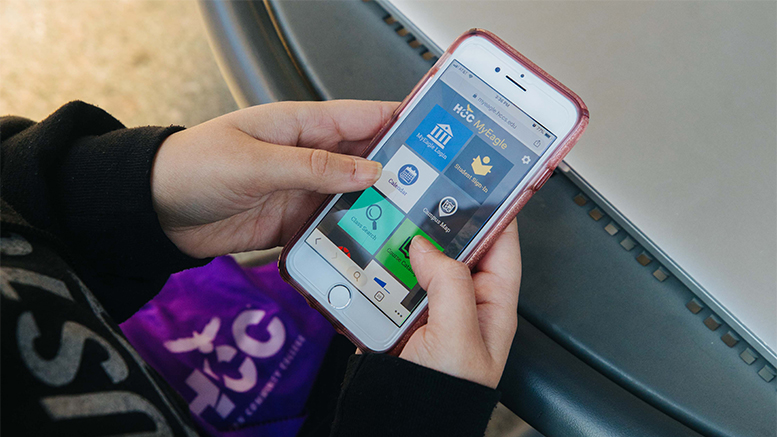Dan Cecchini, chief information officer at Central Oregon Community College (COCC), observes students’ heads buried in their smartphones all the time.
“Students expect that their campuses will have an app,” he says. “If you go to Facebook as an app rather than as a mobile site, why wouldn’t you expect to do the same when seeking information from your college?”
This past September, COCC introduced its COCC mobile app in the iTunes and Google Play Android stores, joining the growing cohort of community colleges with smartphone apps. Though there’s no count of the total number of community colleges with smartphone apps, the iTunes and Google Play stores include numerous community college apps.
The experiences of Cecchini and other community college administrators involved in building apps offer valuable lessons for institutions that seek to do the same.
1) Work with a vendor and integrate with your existing technology.
Ross Domke is the lead web developer at Mott Community College (MCC) in Flint, Michigan. When developing an app, he and MCC sought an outside vendor because, as Domke says, “It would have been a steep learning curve to have developed a cross-platform app on top of all the other tasks being handled by our department.”
MCC selected Aruba Meridian, a Hewlett Packard subsidiary, for their app development, and in 2015, MCC launched an app that integrates access to the college’s student information system with way-finding, location-based technology that provides turn-by-turn directions between campus locations.
Domke advises colleges that seek to introduce apps to select vendors that can integrate with the existing student information systems and with pre-existing apps like emergency alert apps. Another must-have, Domke says, is that the vendor must handle all operating system updates.
“We needed something that would sit in the background and be maintained by the vendor,” he says. “We needed peace of mind that we wouldn’t need to worry about maintenance.”
2) Make the app a one-stop shop.
In the seven-college Houston Community College (HCC) system, William Carter, vice chancellor of information technology, echoes Domke’s insistence on integrating with existing technology and goes a step further by saying that the ideal smartphone app should be a “one-stop shop.”
In 2014, with the support of HighPoint Technology Solutions, HCC launched MyEagle, a web-based front-end to HCC’s PeopleSoft student information system. Two years later, in 2016, a smartphone app was released. Today, the HCC MyEagle online portal and app include more than 30 colorful clickable tile squares that have established the platform as a one-stop shop for HCC’s 115,000 students. Tiles that are titled “My Grades,” “My Financial Aid” and “My Schedule” link to HCC’s PeopleSoft student information system while other tiles connect to the library website, news and social media feeds, the learning management system, HCC’s Microsoft 365 software suite, campus maps, event calendars, faculty resources and more.
MyEagle replaced a glut of systems that students had to log onto previously, Carter says. It is now the universal go-to online platform for students, and as a result of that clarity, student services offices have experienced shorter lines given that more transactions are happening online and seamlessly via smartphones, he says.
Carter’s advice to other campuses is to focus on the student experience and build towards a portal that serves as a one-stop shop.
“Prioritize the mission critical services that need to come first and determine what can be added later,” he says. “Celebrate the successes and continue to monitor the systems for barriers.”
3) Involve and engage your campus colleagues and students when building the app.
At COCC, Cecchini notes that the most frequent feedback he receives from students about the new COCC mobile app is “Why didn’t you launch the app sooner?”
The success that COCC, MCC and HCC have had with their apps suggests that other community colleges should build out apps as well.
Cecchini advises that college administrators working to develop smartphone apps solicit input and buy-in from students and campus colleagues, even when working with an outside vendor on app development, as COCC did with their student information system provider Ellucian.
Darren McCrea, COCC’s technology project manager who facilitated focus group sessions with COCC students, says, “We thought we knew what students wanted in an app, but we quickly found out that we didn’t know anything. The student feedback that we got was really helpful.”
In addition to the student focus groups, Cecchini and McCrea organized two working groups during the app development project — an implementation team and an advisory group. The implementation team brought together staff from departments whose content would feed into the app, such as the registrar and marketing, while the advisory group comprised campus-wide stakeholders with an interest in a successful app.
“While we’re the custodians and facilitators of the technology,” Cecchini says, “we didn’t want to be the sole decision-makers.”
Guided by the input from the two groups, the COCC mobile app has features that Cecchini and McCrea would not have otherwise included. Cecchini says that COCC’s experience demonstrates the benefits of an inclusive app development process, even when the app is built from a trusted off-the-shelf product, as was the case at COCC working from an Ellucian template.
4) Keep incrementally improving.
Cecchini’s final takeaway for campuses considering developing apps is that the work should not end when the app is launched.
“Apps need to be fed and cared for beyond the implementation phase,” he says.

